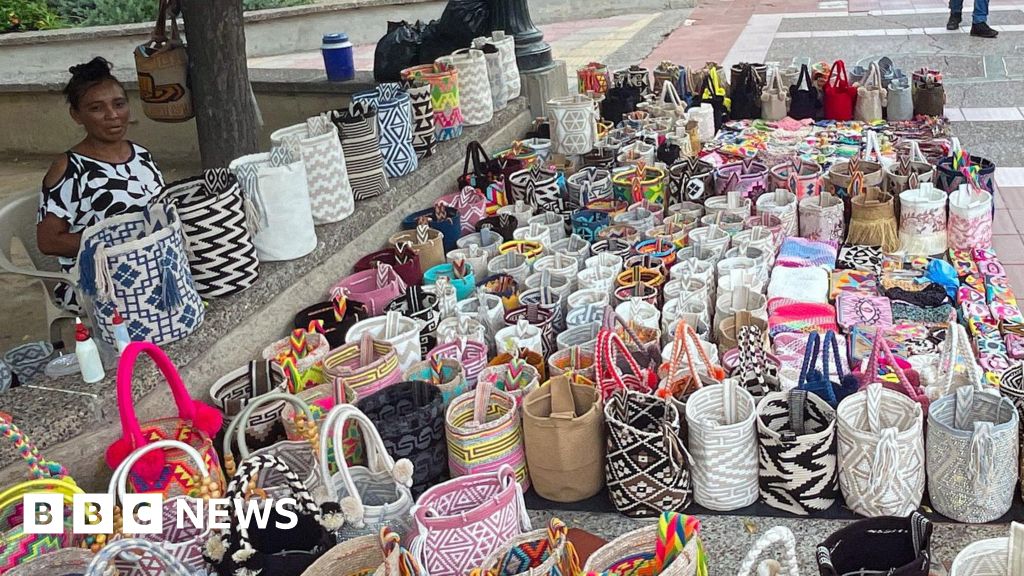Catherine EllisBusiness reporter, Riohacha, Colombia
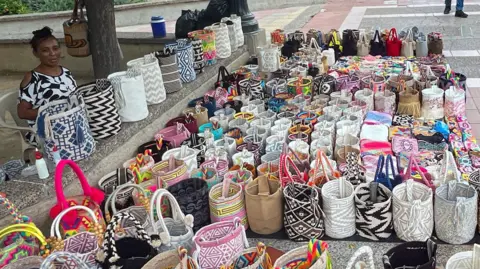 BBC
BBCFor every handwoven bag she sells on the palm-lined promenade of Riohacha, a city on Colombia’s Caribbean coast, Sandra Aguilar feels that she’s sharing a piece of her heritage.
Once used exclusively by the Wayuu, the largest indigenous group in the South American country, the bags – known as mochilas – are now a staple across Colombia, and popular with foreign tourists.
But these days the bags are also increasingly sold in global boutiques, featured at fashion events around the world, and listed on platforms like Etsy, Amazon, and Instagram – reaching buyers who may never have set foot in Colombia.
“Thanks to online posts, international visitors are becoming very knowledgeable about the mochila,” Ms Aguilar says. “They recognise and appreciate its ancestral value.”
Weaving has long been central to the Wayuu people, who number around 380,000 in Colombia. They have lived for centuries on the semi-arid peninsula of La Guajira in the northeast of the country, and extend into neighbouring Venezuela.
Techniques are passed down through generations, with geometric patterns on many mochilas reflecting clan identity, spirituality, and the natural world.
Weaving is also a vital source of income in La Guajira, Colombia’s second-poorest province, where two-thirds of the population live in poverty.
For Ms Aguilar, both domestic mochila sales and exports have improved conditions in her rural Wayuu community of 11 families, and enabled her daughter and niece to attend university.
But while the growing global demand has improved opportunities for some, it has also brought challenges. Many artisans face exploitation, and there are concerns that traditional craftsmanship is being sacrificed for speed and commercial gain.
Some Wayuu women – supported by socially-conscious entrepreneurs – are working to access fairer export markets and promote the mochila’s cultural value.
Prices for Wayuu mochilas vary considerably. A medium-sized lower quality bag – made with simpler designs and weaving techniques – can be found across Colombia for around $20 (£15) – sometimes less.
Higher-end bags typically start at around $80 and can rise to several hundred pounds, depending on the weaving time, complexity of the design.
Traditionally, mochilas were crafted over weeks, but rising demand led many weavers to develop faster techniques, producing simpler designs in two or three days.
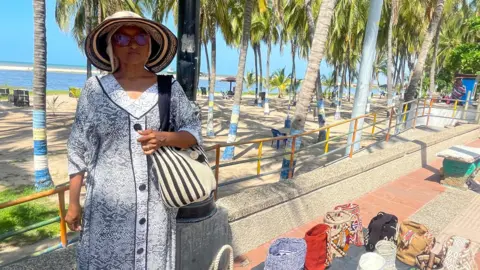
For Colombian entrepreneur Laura Chica, compliments on the Wayuu bag she was using during a trip to Europe sparked a business idea. She founded mochila company Chila Bags back in 2013. “Instagram was just starting, and the brand began to take off,” she says.
Ms Chica says she focuses on high-quality bags incorporating traditional patterns and elements. The bags reflect the artisans’ skills, time, and heritage, for which they receive a fair wage, she says.
Her brand has been featured in magazines, such as Vogue China, and showcased at international fashion weeks and high-end retail spaces from Hawaii to London, Paris and Shanghai.
But does she think the flourishing popularity of mochilas has been beneficial for the Wayuu? For Ms Chica, that very much depends on which market you look at. She says two have developed.
“There are brands, and those interested in the story behind how the bag is made, that want to keep sharing it with the world,” she says. She adds that these provide a market for customers who value indigenous arts, sustainability and fair trade, and are willing to pay more.
But not all weavers have been able to access ways to work with such companies that pay decent prices, says Ms Chica. Instead she says that that many have to rely on a parallel market where quick production, sales and profits are prioritised, which undermines pay and the quality of the work.
In Riohacha’s Mercado Nuevo – a maze-like market bursting with colourful stalls selling yarn, chinchorros (traditional Wayuu hammocks) and mochilas – a group of women crouches on the concrete floor, weaving.
They explain that intermediaries, or middlemen, may offer them as little as $5.50 per bag, but after paying for thread and transport, they often earn as little as $1.50 – excluding the time spent weaving.
Many such Wayuu weavers come from rural, isolated communities where only Wayuunaiki – the Wayuu language – is spoken. This makes it difficult for them to access a broader customer base and navigate economic opportunities. As a result, they sell to the middlemen.
“Some Wayuu women are being forced to accept whatever price, benefiting everyone except the women themselves,” says Paula Restrepo, director of Fundación Talento Colectivo.
Her organisation supports female weavers, whom she and many others recognise as skilled artisans, through education and training.
She is keen to stress that not all intermediaries are harmful. Instead, she says that the reputable ones, which she calls “solidarity intermediaries” help establish an equitable system for purchasing mochilas, ensuring fair wages and safe working conditions through fair trade principles.
Her foundation has partnered with mochila brand and non-profit organisation One Thread Collective to provide the weavers with leadership workshops. “The idea is that the artisans prepare themselves to be autonomous, to be entrepreneurs, to be capable in the future of being in contact with other clients,” says Ms Restrepo.
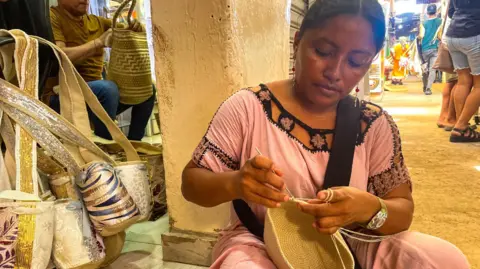
One of the weavers who has taken part in the workshops is Yamile Vangrieken. Sitting on a bright orange chinchorro at her home on the outskirts of Riohacha, she explains she leads a group of eight relatives from the rural community where her family is from.
She acts as a bridge between them – many of whom don’t speak Spanish and haven’t ever been to the city – and One Thread Collective, which helps them export their bags, while providing stable income, thread and microloans.
Ms Vangrieken’s weaving has helped support her teenage daughter, who herself began weaving at just four-years-old. Ms Vangrieken hopes she’ll finish school, go to university, and keep weaving by choice – not out of financial necessity.
While mochilas are gaining international recognition, that doesn’t always translate into higher sales for every business.
Brandon Miller is an American entrepreneur based in Riohacha. He runs Wayuumarket.com, a platform that helps Wayuu artisans sell directly to international buyers.
He says his orders have slumped, not due to a lack of interest, but because more foreign businesses are travelling to La Guajira to source the bags directly, communicating through AI tools like ChatGPT and translation apps.
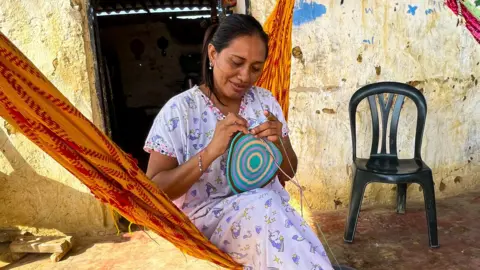
But buying online has changed too. Mr Miller says influencers – especially from China and Thailand – started streaming live from La Guajira on platforms like TikTok, offering real-time purchases to their followers.
Shifts in demand, and how mochilas are sold, have raised concerns about control over the bags’ design, narrative, and profits.
Back on Riohacha’s promenade, Ms Aguilar says the bag’s fashion rise has led artisans to adapt or add elements, such as elaborate beading, religious icons, or even football club logos. She worries that these sales strategies are eroding cultural norms.
But she remains positive. Recognition is increasing – not only of the Wayuu bags – but of the indigenous group and the weavers themselves.
“We are also artists, even if we don’t have a title that says so,” she says.
“Our essence is in our designs, in our products and we mustn’t let that go. When we lose our customs and traditions, we are left with nothing.”
